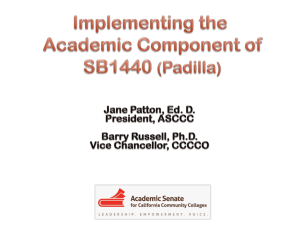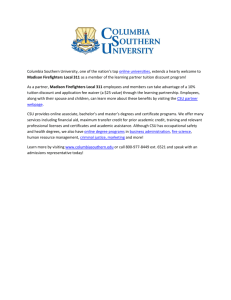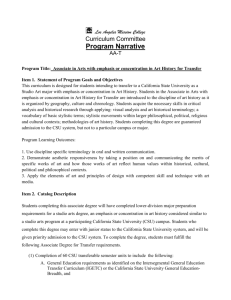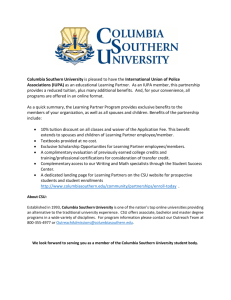Once a student completes an “associate degree
advertisement
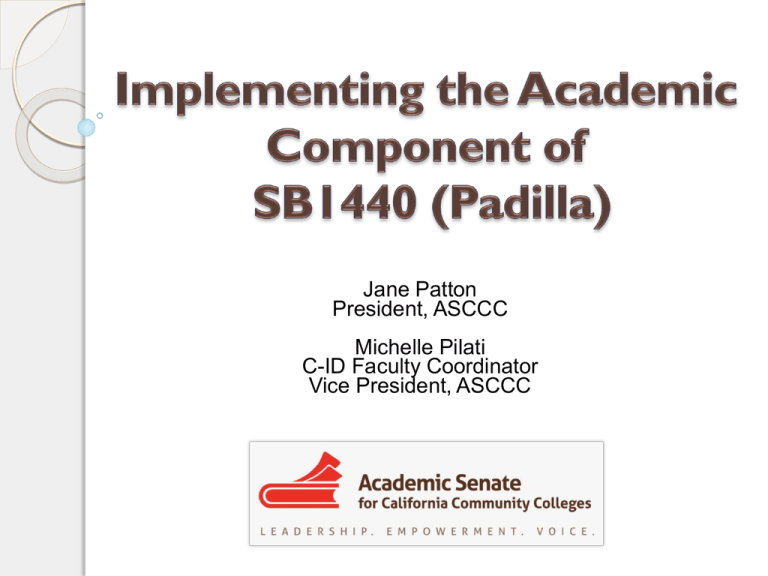
Jane Patton President, ASCCC Michelle Pilati C-ID Faculty Coordinator Vice President, ASCCC 1. To earn an “associate degree for transfer” a student must complete 60 semester units . . . that are eligible for transfer . . . that consist of: IGETC or CSU GE Breadth a major or area of emphasis of at least 18 units, as defined by the CCC 2. No additional local graduation requirements may be required 3. Minimum GPA of 2.0 is required If a student completes an “associate degree for transfer” 1. “the CSU shall guarantee admission with junior status” 2. “Admission to the CSU. . . does not guarantee admission for specific majors or campuses” 3. “the CSU shall grant a student priority admission to his or her local CSU campus and to a program or major that is similar to his or her CC major or area of emphasis, as determined by the CSU campus to which the student is admitted” Once a student completes an “associate degree for transfer” and is at the CSU: “The CSU may require a student transferring pursuant to this article to take additional courses at the CSU so long as the student is not required to take any more than 60 additional semester units or 90 quarter units at the CSU for majors requiring 120 semester units or 180 quarter units.” Once a student completes an “associate degree for transfer” and is at the CSU: “The CSU shall not require students transferring . . . to repeat courses that are similar to those taken at the CC that counted toward the associate degree for transfer.” 112 colleges develop 112 different degrees in each major. . . a concerted, statewide response a transfer model curriculum developed by intersegmental discipline faculty C-ID discipline groups Develop All transfer model curriculum drafts are vetted online Once model curriculum is finalized, colleges may “adopt” Chancellor’s Office will expedite approval Coordination of intersegmental discipline faculty Clear pathways for students statewide Students earn an associate degree, complete major prep, and are given admission priority Appropriate courses for an associate degree Preparation for transfer “Double-counting” 60 units total encouraged Common “core” minimum of 6 units Additional courses selected from list(s) Core – ◦ Introduction to Psychology (SS GE) ◦ Statistics (QR GE) ◦ Research Methods (May be critical thinking) Select one of (LS GE) ◦ Biological Psychology ◦ Introduction to Biology ◦ Human Biology Select one of: ◦ ◦ ◦ ◦ ◦ ◦ ◦ ◦ ◦ ◦ Intro to Biostatistics (CSUCI) Intro to Critical Thinking (Cal Poly, Sonoma) Intro to Child Dev (CSUCI, CSUSB, SLO) Intro to Cognition and Learning (CSUCI) Intro to Family Psychology (SLO) Intro to Learning (SDSU) Intro to Social Psychology (SLO) Intro to Theories of Personality (CSUCI) Lifespan Psychology (CSUSB, SDSU) Intro to Sociology (Cal Poly, Stanislaus) Select one of….. Go to www.c-id.net *Sign up for discipline listservs Provide input to draft TMC Volunteer to help with statewide C-ID and 1440 info@asccc.org Senates & AOs will get updates 11 intersegmental discipline groups met Oct. 7 - 8 All have draft transfer model curriculum Go to www.c-id.net High-Unit Majors/”Highly Sequenced” Consider “ideal” and “acceptable” preparation Consider the limits that small colleges face Develop recommendations
